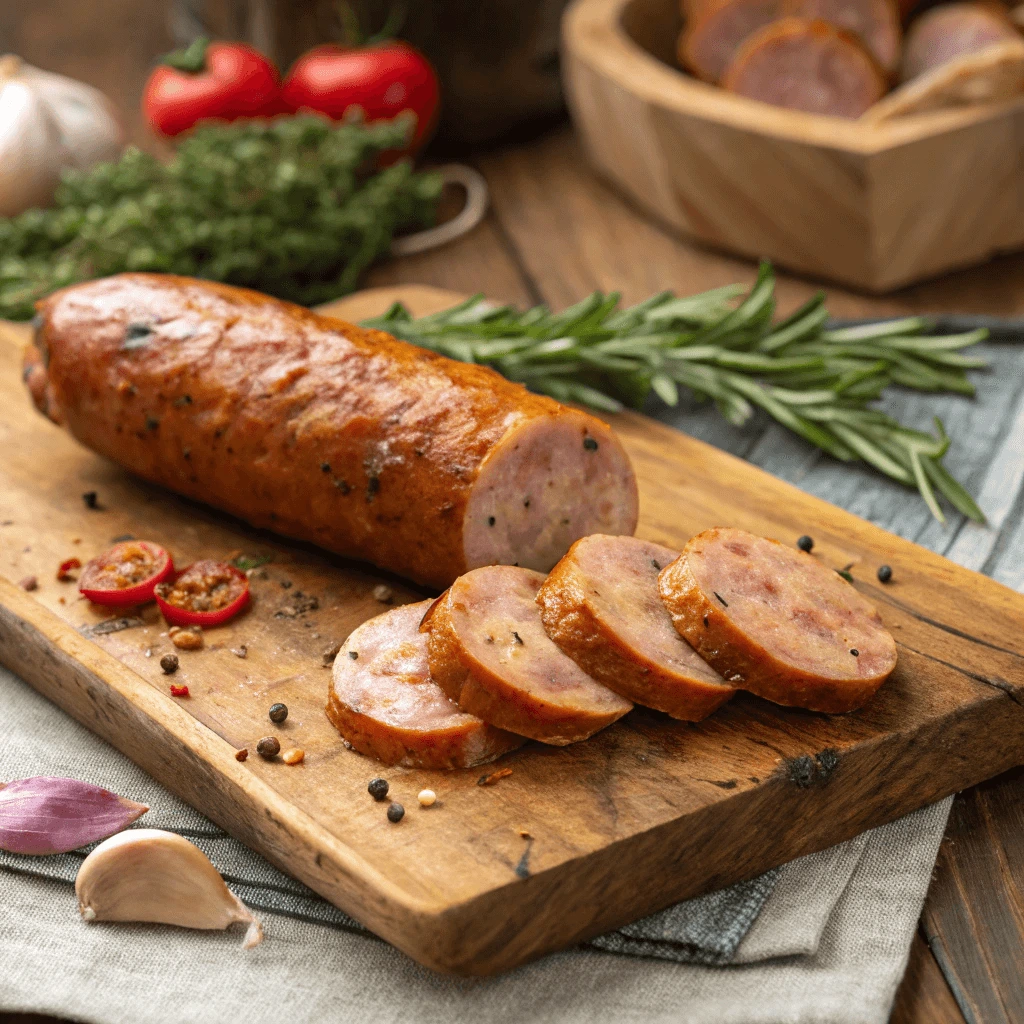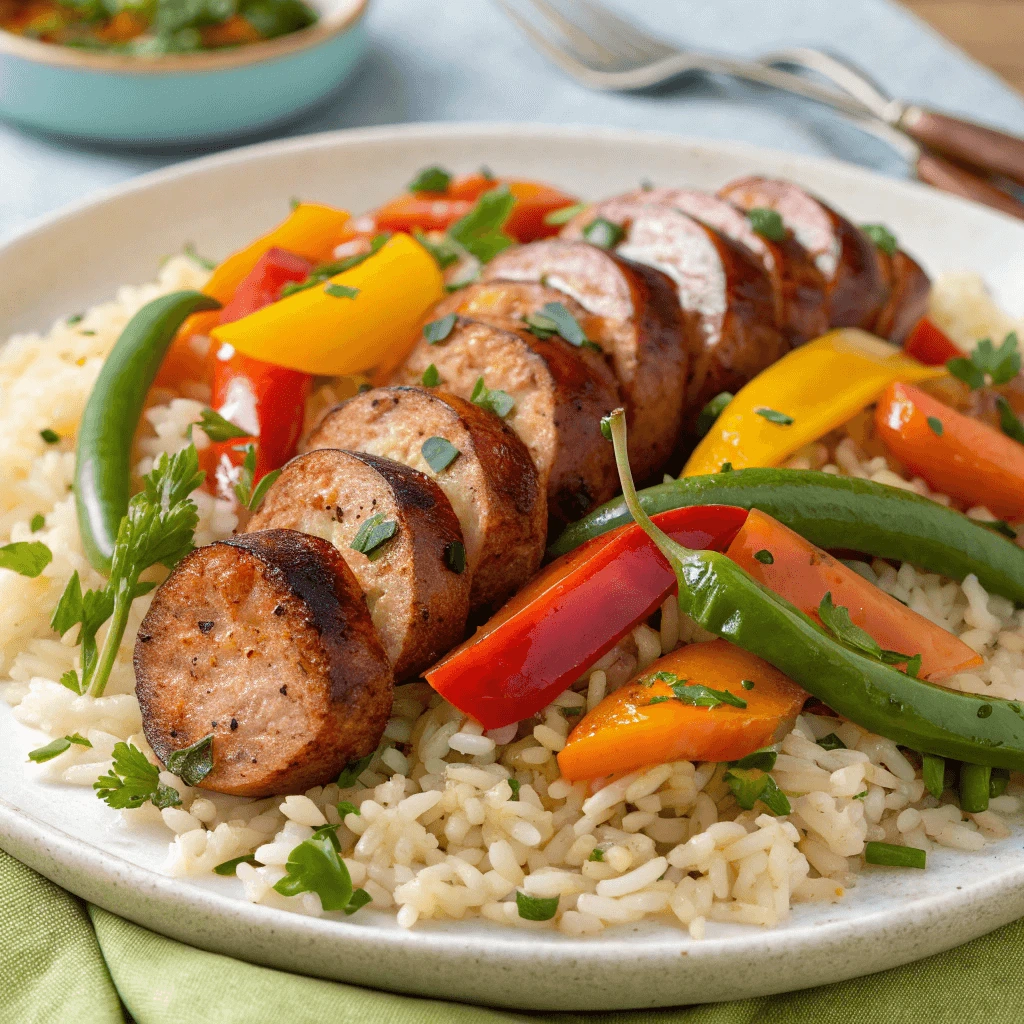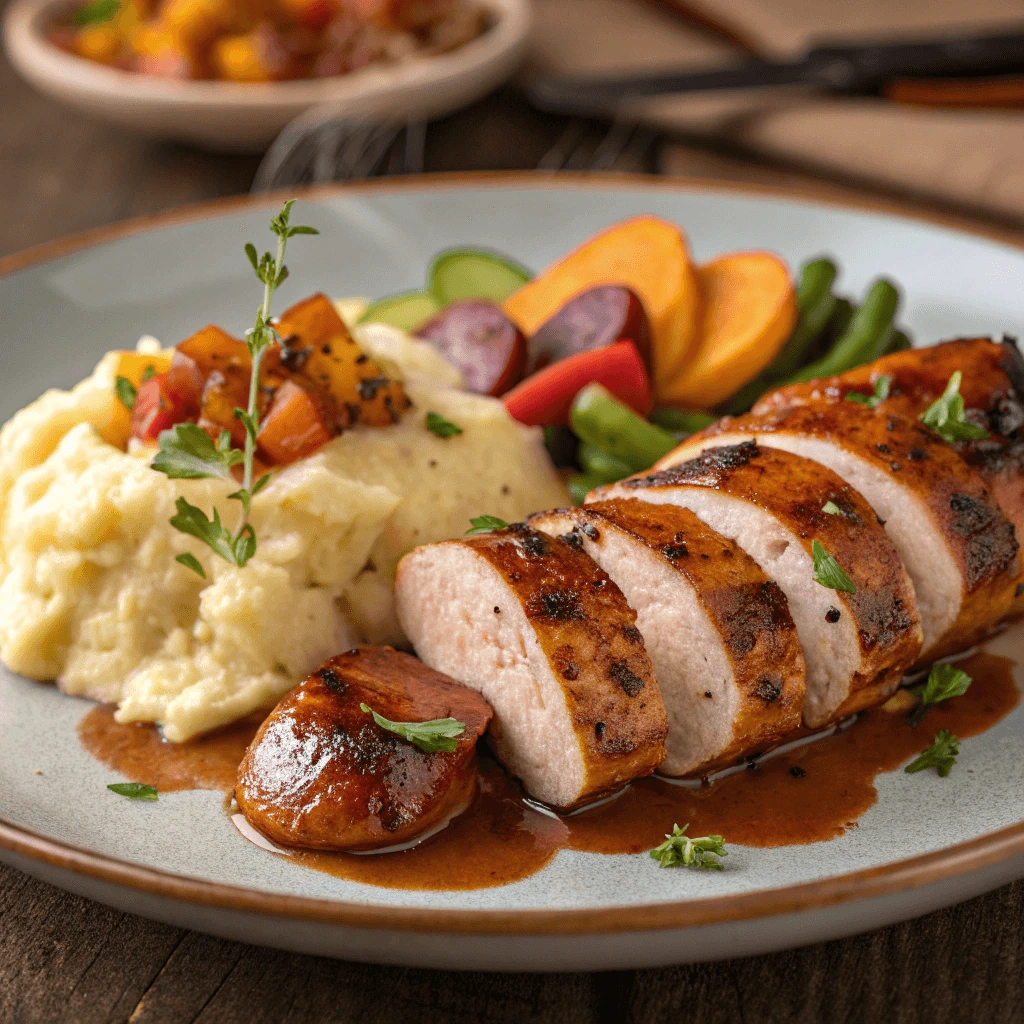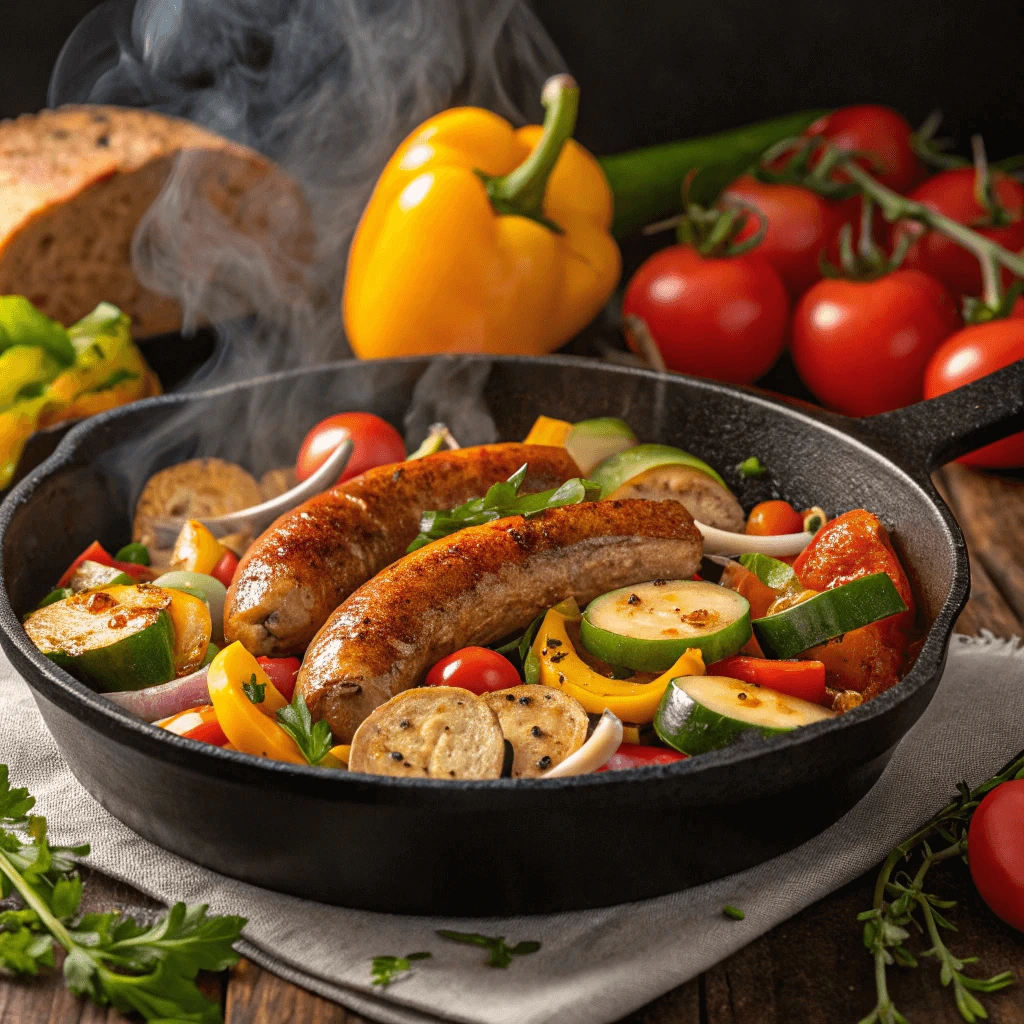If you’re looking to enjoy the bold, smoky flavors Andouille sausage without the heaviness of pork, Chicken Andouille Sausage is the perfect solution. A healthier alternative, chicken sausage provides the same savory taste and satisfying texture, but with fewer calories and less fat. As more people shift toward leaner protein options, chicken sausage has gained popularity, particularly in Cajun-inspired dishes like gumbo, jambalaya, and stir-fries. Not only does it offer a delicious twist on traditional pork sausages, but it also brings a variety of health benefits, making it a great choice for those mindful of their diet. Whether you’re looking to enjoy a healthier sausage for weight management, muscle building, or simply a more nutritious lifestyle, Chicken Andouille Sausage offers a tasty, versatile option that doesn’t sacrifice flavor.
What Makes Chicken Andouille Sausage a Healthy Alternative?

Nutritional Benefits Compared to Pork Sausage
Choosing chicken Andouille sausage offers several health advantages compared to traditional pork sausage.
Lower Fat Content
Chicken, especially lean cuts, has less fat than pork. This makes chicken Andouille a lighter option that supports heart health without sacrificing flavor.
Fewer Calories
Chicken Andouille typically contains fewer calories per serving. This helps those watching their calorie intake enjoy tasty sausage while managing their weight.
High-Quality Protein
Chicken provides lean protein, which helps build muscle and keeps you feeling full longer. This makes chicken Andouille a smart choice for balanced meals.
Better for Heart Health
Because it has less saturated fat and cholesterol than pork, chicken Andouille can reduce the risk of heart-related issues when eaten regularly.
Lean Protein Content in Chicken Sausage
Chicken Andouille sausage provides a good source of lean protein, which is essential for a healthy diet.
What Is Lean Protein?
Lean protein comes from meats that have low fat content. Chicken, especially breast meat, fits this definition well and offers a healthier alternative to fattier sausages.
Why Lean Protein Matters
Lean protein supports muscle growth and repair. It also helps keep you full longer, making it easier to manage your weight.
Protein in Chicken Sausage vs. Pork Sausage
Chicken sausage typically contains less fat but similar amounts of protein compared to pork sausage. This makes it a smart choice for those wanting to reduce fat intake without losing protein benefits.
Lower Fat and Calorie Count
Chicken Andouille sausage stands out for its lower fat and calorie content compared to traditional pork sausage, making it a healthier choice without sacrificing flavor.
Understanding Fat Content
Chicken meat, especially lean cuts like breast or thigh without skin, contains less saturated fat than pork. When you choose chicken Andouille sausage, you reduce your intake of unhealthy fats, which supports heart health and weight management.
Calories in Chicken vs. Pork Sausage
Chicken sausage usually contains fewer calories per serving than pork sausage. Lower calories help control daily energy intake, which is important for maintaining or losing weight.
Health Benefits of Reduced Fat and Calories
Eating lower-fat and lower-calorie foods can decrease the risk of heart disease, high cholesterol, and obesity. Chicken Andouille sausage allows you to enjoy a flavorful meal while keeping these health risks in check.
Cooking Tips to Keep Fat Low
Opt for grilling, baking, or pan-searing with minimal oil to retain the sausage’s low-fat advantage. Avoid frying or adding heavy sauces that increase calories.
Making the Switch
Switching to chicken sausage from pork is an easy way to reduce fat and calories without giving up your favorite Cajun flavors.
Key Ingredients and Seasonings for Authentic Chicken Andouille
Classic Cajun and Creole Spice Blends
The distinctive flavor of Chicken Andouille sausage comes from its classic Cajun and Creole spice blends. These seasonings create the bold, smoky, and slightly spicy taste that defines the sausage.
What Defines Cajun and Creole Flavors?
Cajun and Creole cuisines both originated in Louisiana but have subtle differences. Cajun seasoning tends to be spicier and more rustic, while Creole seasoning is often milder with a blend of herbs and spices. Both, however, use a core set of ingredients that create their signature taste.
Essential Spices in the Blend
Common spices in these blends include paprika, cayenne pepper, garlic powder, onion powder, black pepper, and thyme. Paprika adds smokiness and color, while cayenne provides heat. Garlic and onion powder deepen the savory notes. Thyme brings an earthy, herbal touch.
How These Spices Impact Flavor
Together, these spices create a complex and layered flavor profile. The heat from cayenne is balanced by the sweetness of paprika and the aromatics from herbs. This balance is key to achieving the authentic taste of Andouille sausage.
Using Spice Blends at Home
You can buy pre-made Cajun or Creole spice mixes or create your own blend by combining the essential spices. Adjust the heat level to your preference by varying the amount of cayenne pepper.
Choosing Between Chicken Thighs and Chicken Breast
Selecting the right cut of chicken significantly impacts the flavor, texture, and juiciness of your chicken andouille sausage. The two most common options are chicken thighs and chicken breasts, each offering unique characteristics.
Flavor and Fat Content
Chicken thighs contain more fat compared to chicken breasts. This higher fat content adds richness and moisture to the sausage, resulting in a juicier, more flavorful bite. Conversely, chicken breasts have a milder flavor and less fat, making them a leaner choice but potentially drier if not prepared carefully.
Texture Differences
Thigh meat tends to be more tender and succulent due to its fat and connective tissue. Sausage made with thighs will have a softer, more moist texture. Breast meat, being leaner and firmer, produces a sausage with a slightly denser and firmer bite. Depending on your preference for texture, this difference can be important.
Cooking and Binding Considerations
Because chicken breasts contain less fat, sausages made solely from breast meat may need additional fat or binders like olive oil or natural sausage casings to keep the sausage moist and well-formed. Thigh meat, with its natural fat, usually binds better without extra ingredients.
Health Perspective
If you prefer a leaner sausage with lower fat and calories, chicken breast is the better option. However, if you want richer flavor and juiciness, chicken thighs provide a balance between taste and fat content.
Combining Both Cuts
Many home cooks blend chicken thighs and breasts to get the best of both worlds — the flavor and moisture from thighs combined with the leaner profile of breasts. This mix can create a well-balanced chicken andouille sausage.
Natural vs. Synthetic Sausage Casings
Choosing the right casing is important for making delicious chicken andouille sausage. Casings come in two main types: natural and synthetic. Both have their advantages depending on your needs.
What Are Natural Casings?
Natural casings come from animal intestines, typically from pigs, sheep, or cows. They offer a traditional texture and a satisfying snap when you bite into the sausage. Natural casings allow smoke and seasonings to penetrate, enhancing flavor during cooking.
Pros and Cons of Natural Casings
Natural casings provide a great eating experience, but they require cleaning and preparation before use. They also vary in size, which can make uniform sausages harder to achieve.
What Are Synthetic Casings?
Synthetic casings are made from collagen, cellulose, or plastic. Collagen casings are edible and often used for fresh sausages. Cellulose casings are not edible and must be removed after cooking, while plastic casings are mainly for non-edible uses.
Pros and Cons of Synthetic Casings
Synthetic casings are consistent in size and easier to handle. However, they don’t offer the same texture as natural casings and might not absorb smoke flavors as well.
Which Should You Choose?
For authentic chicken andouille, natural casings are ideal due to their flavor and texture. If you want ease and consistency, collagen casings make a good alternative. Avoid plastic casings for fresh chicken sausage since they don’t enhance flavor.
How to Prepare and Cook Chicken Andouille Sausage

Grinding and Mixing Your Own Sausage at Home
Grinding and mixing your own chicken andouille sausage allows you to control every ingredient, ensuring a fresh, flavorful, and healthier result. This hands-on process can be rewarding and gives you the freedom to customize spice blends and meat textures.
Selecting the Right Equipment
Start with a quality meat grinder or a food processor that can handle raw chicken. A meat grinder attachment for stand mixers also works well. Make sure all equipment is clean and cold to maintain the meat’s freshness and prevent bacterial growth.
Preparing the Chicken
Cut chicken thighs or breasts into small, uniform cubes before grinding. Chilling the chicken in the refrigerator or freezer for 30 minutes makes it easier to grind evenly and results in a better texture.
Grinding the Meat
Feed the chicken pieces through the grinder using a medium-coarse plate for ideal sausage texture. If you prefer a finer grind, run the meat through twice. Avoid over-processing to keep the sausage from becoming too dense or pasty.
Mixing in Seasonings and Spices
After grinding, combine the meat with your spice blend, salt, and any additional ingredients like garlic or herbs. Use your hands or a sturdy spoon to mix thoroughly, ensuring even distribution of flavors throughout the meat.
Achieving the Perfect Texture
Don’t overmix; just enough to bind the meat and spices together. Overworking the mixture can make the sausage tough. For an extra moist sausage, add a small amount of ice-cold water or broth as you mix.
Grinding and mixing sausage at home requires a bit of effort, but the control over ingredients and freshness pays off with delicious, custom-made chicken andouille sausages.
Cooking Techniques
Chicken andouille sausage offers great versatility in cooking methods. Whether you prefer the smoky flavor from a grill or the quick sear from a pan, mastering these techniques brings out the best in this flavorful sausage.
Grilling Chicken Andouille Sausage
Grilling adds a delicious char and smoky flavor that enhances the sausage’s spices. Preheat your grill to medium heat and oil the grates to prevent sticking. Place the sausages on the grill and cook them for about 12-15 minutes, turning occasionally to ensure even browning. Avoid pressing down on the sausages, as this releases juices and dries them out. Grilling also crisps the casing, creating a satisfying texture.
Smoking for Deep Flavor
Smoking infuses chicken andouille with rich, smoky undertones, ideal for slow-cooked dishes. Set your smoker to 225°F (107°C) and use wood chips like hickory or applewood for a balanced aroma. Place the sausages in the smoker for 1.5 to 2 hours, or until they reach an internal temperature of 165°F (74°C). Smoking requires patience but rewards you with complex flavors and a tender bite.
Pan-Searing for Quick and Easy Cooking
Pan-searing offers a fast, convenient way to cook chicken andouille while maintaining juiciness. Heat a small amount of oil over medium-high heat in a skillet. Add the sausages and cook for about 10-12 minutes, turning frequently to brown all sides evenly. This method creates a caramelized crust and keeps the inside moist. For extra flavor, add sliced onions or bell peppers to the pan.
Tips for Perfect Texture and Flavor
Getting the texture and flavor just right in chicken andouille sausage takes some care and attention. By following a few key tips, you can ensure your sausage turns out juicy, flavorful, and perfectly seasoned every time.
Use the Right Meat Blend
Start with a good balance of lean chicken meat and some fat, such as skin-on thighs or a bit of chicken fat. Fat keeps the sausage moist and tender during cooking. If you use only breast meat, the sausage can become dry and crumbly. Aim for about 20-30% fat content for optimal texture.
Keep Ingredients Cold
When grinding and mixing your sausage, keep the meat and seasonings well-chilled. Cold meat grinds more cleanly and holds together better. Warm meat can become mushy and lose its structure, affecting the sausage’s bite and juiciness.
Don’t Overmix the Sausage
Mix the meat and spices just enough to combine them thoroughly. Overmixing can break down the meat fibers too much, leading to a dense or rubbery texture. Gentle mixing ensures a tender, cohesive sausage that holds its shape well.
Season Generously but Balanced
Chicken has a mild flavor, so chicken andouille sausage benefits from bold, balanced seasoning. Use a combination of smoked paprika, cayenne, garlic powder, thyme, and black pepper for that authentic Cajun kick. Taste your seasoning blend before mixing with the meat to adjust the heat and salt levels.
Test and Adjust with a Small Patty
Before stuffing all your sausage casings, cook a small patty of the mixture to test the flavor and texture. This step lets you tweak seasoning or fat content without wasting large batches. Adjust as needed until you achieve the perfect balance.
Proper Cooking Temperatures
Cook your sausage to an internal temperature of 165°F (74°C) to ensure safety while preserving moisture. Use a meat thermometer for accuracy. Overcooking dries out the sausage, while undercooking can be unsafe and unpleasant.
Health-Conscious Recipes Featuring Chicken Andouille

Low-Calorie Cajun Jambalaya with Chicken Sausage
Creating a low-calorie Cajun jambalaya featuring chicken sausage allows you to enjoy a flavorful, hearty meal without the extra calories often found in traditional recipes. By carefully choosing ingredients and cooking techniques, you can keep the dish light yet satisfying.
Choosing Lean Chicken Sausage
Start by selecting lean chicken andouille sausage, which reduces fat content significantly compared to pork versions. This substitution lowers overall calories while maintaining that signature smoky, spicy flavor. Opt for sausages with minimal added fillers or preservatives for a cleaner taste.
Using Brown Rice or Cauliflower Rice
Swap out white rice for brown rice or cauliflower rice to increase fiber and reduce calories. Brown rice adds a nutty flavor and provides lasting energy, while cauliflower rice offers a low-carb, nutrient-dense alternative that blends seamlessly with the spices.
Load Up on Vegetables
Boost volume and nutrition by adding plenty of vegetables such as bell peppers, onions, celery, and tomatoes. These ingredients add natural sweetness, color, and texture, making each bite more interesting and nutritious. Vegetables also increase fiber content, helping you feel fuller longer.
Flavoring with Classic Cajun Spices
Build layers of flavor by using a blend of paprika, cayenne, garlic powder, onion powder, thyme, and black pepper. These spices add warmth and complexity without extra calories. Fresh herbs like parsley or green onions can brighten the dish just before serving.
Cooking Method for a Healthy Meal
Prepare jambalaya in a single pot to retain moisture and minimize added fats. Sauté vegetables with a small amount of olive oil or cooking spray instead of butter or heavy oils. Simmer the sausage, rice, and vegetables together to meld flavors without adding unnecessary calories.
Spicy Chicken Andouille Gumbo for a Balanced Meal
Spicy chicken andouille gumbo offers a flavorful, balanced meal packed with lean protein and vegetables. Using chicken sausage keeps the dish lighter than traditional pork versions.
Flavorful Base and Vegetables
Begin by making a roux with flour and oil, stirring until it turns a rich brown. Then, sauté onions, celery, and bell peppers—the Cajun “holy trinity”—to build a savory foundation. Add fresh okra and tomatoes for texture and nutrients.
Adding Lean Protein
Slice chicken andouille sausage and add it to the pot along with shredded chicken breast. This combination boosts protein content while keeping fat levels low.
Perfect Spice and Simmer
Season with cayenne, garlic, thyme, and bay leaves for that authentic Cajun heat. Let the gumbo simmer to blend flavors fully. Serve over brown rice or cauliflower rice for a satisfying, healthy meal.
Quick and Healthy Pasta Dishes with Chicken Andouille
Chicken andouille sausage adds a flavorful, spicy kick to pasta dishes while keeping meals lean and nutritious. Its bold taste pairs perfectly with fresh vegetables and wholesome pasta options, making it ideal for quick, healthy dinners.
Choosing the Right Pasta
Opt for whole wheat or legume-based pasta varieties to boost fiber and protein content. These healthier alternatives complement the lean protein in chicken andouille, creating a well-rounded meal.
Simple Vegetable Add-Ins
Incorporate colorful vegetables like spinach, cherry tomatoes, bell peppers, or zucchini. Sauté them lightly to retain nutrients and add vibrant texture and flavor to your dish.
Quick and Tasty Sauce Ideas
Prepare a light tomato-based sauce with garlic, onions, and fresh herbs to balance the smoky spice of the sausage. Alternatively, use a low-fat creamy sauce made from Greek yogurt or cashew cream for a luscious yet healthy finish.
Cooking and Combining
Slice the chicken andouille sausage and sauté it until browned. Toss the cooked pasta with the sausage and vegetables, then mix in your chosen sauce. This quick method keeps the meal fresh, flavorful, and ready in under 30 minutes.
Storing, Freezing, and Reheating Chicken Andouille Sausage
Best Practices for Safe Storage and Freezing
Proper storage and freezing techniques preserve the flavor and safety of your chicken andouille sausage. Following these steps ensures your sausage stays fresh and delicious until you’re ready to enjoy it.
Refrigeration Guidelines
Store fresh chicken andouille sausage in the refrigerator immediately after purchase or preparation. Keep it in airtight containers or tightly wrapped in plastic wrap or aluminum foil to prevent exposure to air, which can cause spoilage. Use the sausage within 3 to 4 days to enjoy optimal freshness.
Preparing Sausage for Freezing
Before freezing, divide the sausage into portions that suit your typical meal size. Wrap each portion tightly in plastic wrap and then place them in a freezer-safe bag or container. Remove as much air as possible to avoid freezer burn and preserve flavor.
Labeling and Dating
Clearly label each package with the date you froze it. This practice helps you keep track of storage times. For best quality, consume frozen chicken andouille sausage within 2 to 3 months.
Thawing Safely
Thaw frozen sausage in the refrigerator overnight for a safe and gradual process. Avoid thawing at room temperature, as this can encourage bacterial growth. For faster thawing, you can use the microwave’s defrost setting, but cook the sausage immediately afterward.
Avoiding Refreezing
Do not refreeze sausage that has fully thawed, as repeated freezing and thawing can degrade texture and increase food safety risks.
How to Thaw and Handle Sausage Properly
Proper thawing and handling of chicken andouille sausage play a crucial role in maintaining food safety and preserving flavor. Follow these guidelines to enjoy your sausage at its best while preventing contamination.
Safe Thawing Methods
Thaw your sausage safely by transferring it from the freezer to the refrigerator at least 12–24 hours before cooking. This slow, controlled thawing keeps the sausage at a safe temperature, minimizing the risk of bacterial growth. Avoid thawing sausage on the countertop or in warm water, as these methods can allow harmful bacteria to multiply.
If you need to thaw sausage quickly, use your microwave’s defrost setting. However, cook the sausage immediately after thawing to ensure safety.
Handling Fresh and Thawed Sausage
Always wash your hands with soap and warm water before and after handling raw sausage. Use separate cutting boards and utensils for raw meat and other foods to avoid cross-contamination.
When unwrapping the sausage, do so on a clean surface and avoid letting juices drip onto other foods or kitchen surfaces. Immediately clean any spills with hot, soapy water.
Storing After Thawing
If you thaw sausage in the refrigerator and don’t plan to cook it right away, keep it refrigerated and use it within 1 to 2 days for best quality and safety. Never refreeze sausage that has fully thawed unless you cook it first.
Reheating Without Losing Flavor or Moisture
Reheating chicken andouille sausage properly ensures it stays juicy, flavorful, and enjoyable even when served later. Using the right techniques preserves the texture and enhances the overall eating experience.
Choosing the Best Reheating Method
To retain moisture, avoid reheating sausage at high temperatures for too long. The microwave heats food unevenly and can dry out the sausage quickly. Instead, opt for gentler methods like stovetop warming or oven reheating.
Reheating on the Stovetop
Place your sausage in a skillet over medium-low heat. Add a small splash of water, broth, or olive oil to keep it moist. Cover the pan with a lid to trap steam, which helps maintain juiciness. Turn the sausage occasionally to heat it evenly and prevent burning. This method warms the sausage gently and preserves its smoky flavor.
Oven Reheating for Even Results
Preheat your oven to 325°F (163°C). Wrap the sausage in aluminum foil to lock in moisture. Place the wrapped sausage on a baking sheet and heat it for about 10–15 minutes. This technique evenly reheats the sausage without drying it out. For a slight crisp on the outside, open the foil in the last few minutes.
Avoid Overheating
Overcooking sausage during reheating causes it to lose moisture and become tough. Remove the sausage from heat as soon as it reaches an internal temperature of 165°F (74°C) to ensure it’s safe and delicious.
Using Sauces and Condiments
Pair reheated sausage with flavorful sauces or condiments like mustard, spicy remoulade, or barbecue sauce. These add moisture and enhance the taste, making leftovers feel fresh and vibrant.
Conclusion
Chicken Andouille Sausage offers a flavorful and healthier alternative to traditional pork sausage. With its leaner protein content, lower fat, and fewer calories, it fits perfectly into a balanced diet without sacrificing taste. Infused with classic Cajun spices, this sausage brings bold flavors to your meals while supporting your health goals. Whether grilled, smoked, or sautéed, chicken andouille provides versatility and nutrition in one delicious package. Embrace this tasty substitute to enjoy all the rich flavors of andouille sausage with a lighter, wholesome twist.
